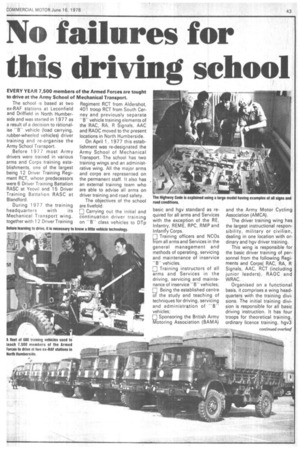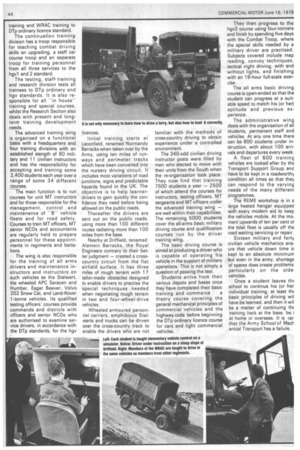No failures for this driving school
Page 45

Page 46

If you've noticed an error in this article please click here to report it so we can fix it.
EVERY YEAR 7,500 members of the Armed Forces are taught to drive at the Army School of Mechanical Transport.
The school is based at two ex=RAF stations at Leconfield and Driffield in North Humberside and was started in 1,977 as a result of a decision to rationalise "13" vehicle (load carrying, rubber-wheeled vehicles) driver training and re-organise the Army School Transport.
Before 1977 most Army drivers were trained in various arms and Corps training establishments, one of the largest being 12 Driver Training Regiment RCT, whose predecessors were 6 Driver Training Battalion RASC at Yeovil and 15 Driver Training Battalion RASC at Blandford.
During 1977 the training headquarters with its Mechanical Transport wing, together with 12 Driver Training Regiment RCT from Aldershot, 401 troop RCT from South Cerney and previously separate "B" vehicle training elements of the RAC, RA, R Signals, AAC and RAOC moved to the present locations in North Humberside.
On April 1, 1 977 this establishment was re-designated the Army School of Mechanical Transport. The school has two training wings and an administrative wing. All the major arms and corps are represented on the permanent staff. It also has an external training team who are able to advise all arms on driver training and road safety.
The objectives of the school are fivefold: Carrying out the initial and continuation driver training on "B" class vehicles to DTp basic and hgv standard as required for all arms and Services with the exception of the RE, Infantry, REME, RPC, RMP and I nfa nt'ty Corps.
Training officers and NCOs from all arms and Services in the general management and methods of operating, servicing and maintenance of inservice "B" vehicles.
Training instructors of all arms and Services in the driving, servicing and maintenance of inservice "B" vehicles; ni Being the established centre of the study and teaching of techniques for driving, servicing and administration of "Be' vehicles;
n Sponsoring the British Army Motoring Association (BAMA)
and the Army Motor Cycling Association (AM CA).
The driver training wing has the largest instructional responsibility, military or civilian, dealing in one location with ordinary and hgv driver training.
This wing is responsible for the basic driver training of personnel from the following Regiments and Corps( RAC, RA, R Signals, AAC, RCT {including junior leaders), RAOC and WRAC.
Organised on a functional basis, it comprises a wing headquarters with the training divisions, The initial training division is responsible for all basic driving instructibn. It has four -troops for theoretical training, ordinary licence training, hgv3
training and WRAC training to DTp ordinary licence standard.
The continuation training division has a troop responsible for teaching combat driving skills on upgrading, a staff car course troop and an separate troop for training personnel from all three services to the hgvl and 2 standard.
The testing, staff training and research division tests all trainees to DTp ordinary and hgv standards. It is also responsible for all "in house" training and special courses, whilst the Research Section also deals with present and longterm training development needs.
The advanced training wing is organised on a functional basis with a headquarters and four training divisions with an established stength of 60 military and 11 civilian instructors and has the responsibility for accepting and training some 2,400 students each year over a range of some 34 different courses. _
The main function is to run courses for unit MT instructors and for those responsible for the management, control and maintenance of "B" vehicle fleets and for road safety. Courses to train MT officers, MT senior NCOs and accountants are regularly held to prepare personnel for these appointments in regiments and battalions.
The wing is also responsible for the training of all arms drivers and maintenance instructors and instructors on such vehicles as the Stalwart, the wheeled APC Saracen and Humber, Eager Beaver, Volvo 202 Snow Cat, and Land-Rover 1-tonne vehicles. Its qualified testing officers' courses provide commands and districts with officers and senior NCOs who are authorised to examine service drivers, in accordance with the DTp standards, for the hgv licences.
Initial training starts at Leconfield, renamed Normandy Barracks when taken over by the Army, using ten miles of runways and perimeter tracks which have been converted into the nursery driving circuit. It includes most variations of road junctions, signs and predictable hazards found in the UK. The objective is to help learnerdrivers to gain quickly the confidence they need before being allowed on the public roads.
Thereafter the drivers are sent out on the public roads, using more than 100 different routes radiating more than 100 miles from the base.
Nearby at Driffield, renamed Alamein Barracks, the Royal Engineers contrary to their better judgment — created a crosscountry circuit from the flat airfield surface. It has three miles of rough terrain with 17 tailor-made obstacles designed to enable drivers to practise the special techniques needed when negotiating rough terrain in two and four-wheel-drive vehicles.
Wheeled armoured personnel carriers, amphibious Stalwarts and trucks can be driven over the cross-country track to enable the drivers who are not familiar with the methods of cross-country driving to obtain experience under a controlled environment.
The 340-odd civilian driving instructor posts were filled by men who elected to move with their units from the South when the re-organisation took place. They now find that training 7500 students a year — 2500 of which attend the courses for instructors, testing officers, MT sergeants and MT officers under the advanced training wing — are well within their capabilities. The remaining 5000 students cover the all-arms basic military driving course and qualification courses run by the driver training wing.
The basic driving course is aimed at producing a driver who is capable of operating his vehicle in the support of military operations. This is not simply a question of passing the test.
Students arrive from their various depots and bases once they have completed their basic training and commerce a theory course covering the general mechanical principles of commercial vehicles and the highway code before beginning the DTp ordinary licence course for cars and light commercial vehicles. They then progress to the hgv3 course using four-tonners and finish by spending five days with the Combat Troop, where the special skills needed by a military driver are practised. Subjects covered include map reading, convoy techniques, tactical night driving, with and without lights, and finishing with an 18-hour full-scale exercise.
The all arms basic driving course is open-ended so that the student can progress at a suitable speed to match his (or her) aptitude and previous experience.
The administrative wing deals with the organisation of all students, permanent staff and vehicles. At any one time there can be 800 students under instruction, with about 100 arrivals and departures every week.
A fleet of 600 training vehicles are looked after by the Transport Support Group and have to be kept in a roadworthy condition all times so that they can respond to the varying needs of the many different programmes.
The REME workshop is in a large heated hangar equipped with every modern aid to keep the vehicles mobile. At the moment upwards of ten per cent ol the total fleet is usually off the road waiting servicing or repair.
Sixteen military and forty civilian vehicle mechanics ensure that vehicle down time is kept to an absolute minimum but even in the army, shortage of spares does create problems particularly on the olde vehicles, Once a student leaves th( school to continue his (or her individual training, at least thE basic principles of driving wil have be learned, and then it wil be a matter of continuing th( training back at the base, be i at home or overseas. It is rar that the Army School of Mech anical Transport has a failure.
















































































































